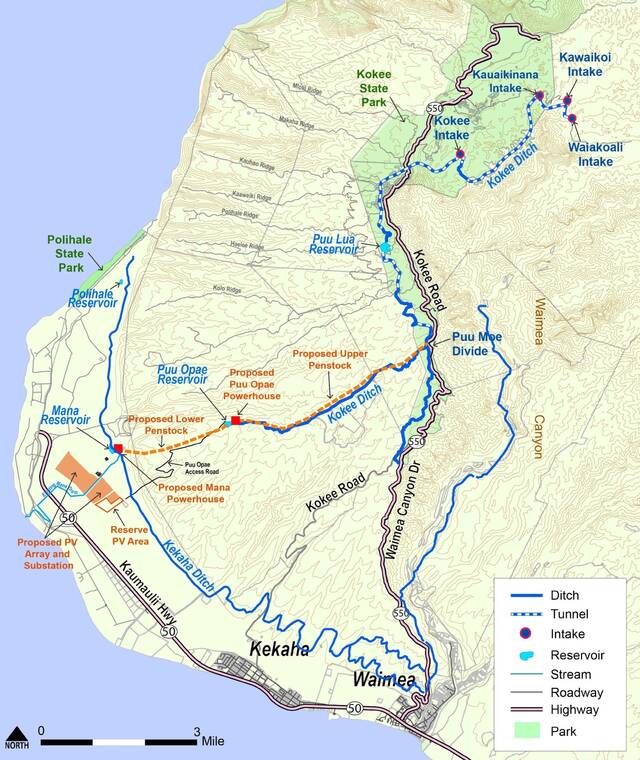WAIMEA — Water dominated this week’s “Talk Story Tuesday” meeting between Kaua‘i Island Utility Cooperative personnel and residents with a stake in the West Kaua‘i Energy Project.
The proposed project encompasses an approximately 350-acre solar farm on the Mana Plain, hydro-powered energy storage and generation, and rehabilitated reservoirs, irrigation systems and roads throughout the island’s West Side. It will eliminate up to 8.5 million gallons of fossil fuel annually and provide 25% of Kaua‘i’s total energy when completed – but community members desire more information.
“Since our last meeting, several questions have continued to surface about the project, and in particular about the use of water,” KIUC President and CEO David Bissell said Tuesday.
The design and scope of the WKEP’s water use stem from a “historic” 2017 mediation agreement between Hawaiian farmers, the Department of Hawaiian Home Lands, KIUC, the Kekaha Agricultural Association and the Agricultural Development Corporation, all of whom laid claim to water flowing in the Waimea River. Under the settlement, KIUC committed to a combination flow-through hydropower and pump storage design, and to providing reliable irrigation delivery to nearby DHHL plots.
“Without these improvements, DHHL plans for the area would not proceed, and KAA would continue to receive water from the Kekaha Ditch, which does not serve DHHL lands,” Bissell said.
DHHL Consultant Jonathan Scheuer said the 2017 agreement ties the fate of the 230-acre Pu‘u ‘Opae Kuleana Homestead Settlement Plan to the energy project’s success.
“The millions of dollars of infrastructure that would be necessary to efficiently take this water from the existing diversions to our lands, would be something that the (DHHL) Commission probably would not be able to invest in, when there’s demand from beneficiaries for lots in other areas,” Scheuer said. “So this is going to allow these lands to be opened up.”
The still-active mediation agreement also ensures certain environmental protections and oversight on the Waimea River.
A handful of residents, including two hunters, spoke following KIUC personnel and Scheuer’s respective presentations.
Issues raised included KIUC’s plans to replace certain ditches with buried pipes. One hunter worried doing so will negatively affect hunting and erosion, by reducing the number of open water sources for game animals and plants.
Another hunter, Klayton Kubo, shared similar concerns.
“Klayton reminds me of this every time we have a meeting … and the answer to it is, access to the area is going to be governed by DHHL, the landowner,” Bissell said. “But as we have said in the past, it will be our plan – provided there’s hunting allowed in that immediate area – to work with the hunters and come up with supplemental ways if the animals are impacted … we’re gonna have to work together.”
At least one resident aired their skepticism of the energy plan’s reportedly negligible impact on the Waimea River. Another asked Scheuer if DHHL, as a property owner leasing land to KIUC for the energy project, would spend that money locally.
Scheuer could not provide a definitive answer.
“Ultimately, the decision on how to spend trust funds falls to the Hawaiian Homes commissioners themselves,” he explained. “I’ve certainly seen a pattern where if the revenue is generated in an area, there tends to be some level of attention to that area from that revenue, but not all of it.”
The DHHL consultant also addressed the Pu‘u ‘Opae Kuleana Homestead Settlement’s permitted diversion of 6.9 million gallons per day, to irrigate the planned homestead lots. Speaking to resident Kawai Warren, who argued the plan is wasteful, Scheuer said the daily allotment is based on a conservative estimate of need.
Warren also asked for a projection of time needed by future homesteaders to utilize all 6.9 million gallons. Scheuer said he hoped it will only take a few years for farmers to match their allotted water supply.
“It’s our mission, it’s our fiduciary obligation and also our passion to see that these lands be used and occupied and thrive,” Scheuer said. “… We can help provide some of the infrastructure in conjunction with KIUC and other efforts, but we can’t make people successful and make homesteaders successful. We kind of set up the situation to hope that that occurs.”
The next KWEP Talk Story Tuesday meeting is scheduled for Tuesday, Nov. 9. A time and virtual or in-person location have yet to be determined.






How will this project impact all of the waste water that is pumped into the ocean at First Ditch, Second Ditch, Kinikini ditch and Nohili ditch? It’s hard to believe the west side lets this happen. Please go on Google Earth to witness the pollution this pumping does to our ocean.
1st the westside gets stuck with the land field, now known as “Mount Opala”. Now you want to create more eye sore by placing a 350 acre solar farm? Do it on the north shore, why always messing with the westside?
We are going to have to be innovative for the future if we are going to meet our energy needs. It is hard for me to fathom how much we protest the very innovations to lower CO2 emissions that we say we want. Kauai gets enough water, just not evenly distributed. check out the DOE’s site on this technology, this could bring science and technology jobs to the island. https://www.energy.gov/eere/water/pumped-storage-hydropower